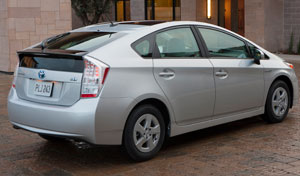
Toyota Motor Sales U.S.A. Inc. regained some footing in March, as stepped-up incentives brought buyers back to showrooms and put the auto maker near the top of the U.S. sales charts for the month.
Toyota delivered 186,863 vehicles in March, up 35.3% on a daily-rate basis from year-ago and a giant 72.4% jump from February levels, according to Ward’s data. The performance put the auto maker within 2,000 units of leading-seller General Motors Co. and ahead of Ford Motor Co. for the month.
“We took a big step in the right direction,” says Don Esmond, senior vice president-Automotive Operations, who admits incentives were a big factor in the auto maker’s successful March. Improved weather also helped, he says, and the industry overall benefited from strong fleet sales.
The Toyota spiffs expire April 5, but Esmond says the company is reviewing its programs now and will do what it takes to “keep dealers competitive as we get back to business and the market recovers.
“We need a bit of kick start to get the market moving in our direction, (and) I’m sure our customers will continue to see great deals,” he adds. “(But) incentives are a short-term tactical approach at Toyota, not long-term strategy.”
Edmunds.com says Toyota’s incentive costs totaled $2,256 in March, a record high for the auto maker and up from $1,881 in February and $1,565 year-ago. Still, the website says Toyota’s spend was well below GM’s $3,519 and less than the industry average of $2,742.
Esmond doesn’t believe the incentive program pulled sales ahead into March as much as it relieved pent-up demand caused by Toyota’s recall controversy.

About 60% of the auto maker’s sales in March went to previous Toyota buyers. That’s a fairly typical rate that indicates there’s “continued confidence in the safety and quality of Toyota vehicles,” Esmond says.
In fact, several models caught up in the various recalls did perform well during the month.
Camry demand jumped 35.2% on a daily basis and Prius sales were up 27.0% from year-ago. RAV4 deliveries more than doubled to an any-month record 25,781 units, up from 11,899 in March 2009. Highlander sales soared 112.7%.
Also more than doubling was the 4Runner, up 139.4% to 4,108.
In all, Toyota car sales rose 24.4% and light trucks gained 52.1%.
Among models not performing well were the three Scion vehicles, which collectively saw a 27.6% decline, according to Ward’s data. Toyota officials say the brand’s sales will improve as the revamped tC and all-new iQ, both unveiled at the New York auto show this week, reach U.S. dealers. The new tC goes on sale later in the year, and the iQ arrives in 2011.
Esmond says showroom traffic last month fluctuated greatly depending on how Toyota’s sudden-acceleration controversy was playing out in the media.
“There were three different parts of the month,” he says. “March came in like a lion, with sales up 40% in the first 10 days. Then highly sensationalized reports slowed Prius sales.”
After more favorable reports hit refuting a couple of sudden-acceleration claims involving the Prius, sales of the hybrid picked back up again, and overall Toyota ended the month with its best weekend since August, when the U.S. “Cash for Clunkers” program was under way, Esmond says.
Toyota says about 9% of its sales last month went to fleet customers, and it ended March with about a 60-day supply of Toyota-brand vehicles and a 40-day stock of Lexus models.




